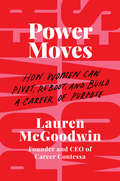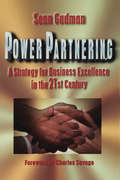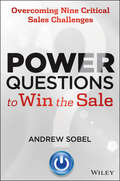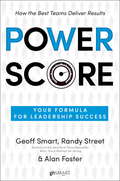- Table View
- List View
Power Metal: The Race for the Resources That Will Shape the Future
by Vince BeiserThe powerful ways the metals we need to fuel technology and energy are spawning environmental havoc, political upheaval, and rising violence - and how we can do better.An Australian millionaire's plan to mine the ocean floor. Nigerian garbage pickers risking their lives to salvage e-waste. A Bill Gates-backed entrepreneur harnessing AI to find metals in the Arctic.These people and millions more are part of the intensifying competition to find and extract the minerals essential for two crucial technologies: the internet and renewable energy. In Power Metal, Vince Beiser explores the Achilles' heel of "green power" and digital technology - that manufacturing computers, cell phones, electric cars, and other technologies demand skyrocketing amounts of lithium, copper, cobalt, and other materials. Around the world, businesses and governments are scrambling for new places and new ways to get those metals, at enormous cost to people and the planet.Beiser crisscrossed the world to talk to the people involved and report on the damage this race is inflicting, the ways it could get worse, and how we can minimize the damage. Power Metal is a compelling glimpse into this disturbing yet potentially promising new world.
Power Metal: The Race for the Resources That Will Shape the Future
by Vince BeiserThe powerful ways the metals we need to fuel technology and energy are spawning environmental havoc, political upheaval, and rising violence - and how we can do better.An Australian millionaire's plan to mine the ocean floor. Nigerian garbage pickers risking their lives to salvage e-waste. A Bill Gates-backed entrepreneur harnessing AI to find metals in the Arctic.These people and millions more are part of the intensifying competition to find and extract the minerals essential for two crucial technologies: the internet and renewable energy. In Power Metal, Vince Beiser explores the Achilles' heel of "green power" and digital technology - that manufacturing computers, cell phones, electric cars, and other technologies demand skyrocketing amounts of lithium, copper, cobalt, and other materials. Around the world, businesses and governments are scrambling for new places and new ways to get those metals, at enormous cost to people and the planet.Beiser crisscrossed the world to talk to the people involved and report on the damage this race is inflicting, the ways it could get worse, and how we can minimize the damage. Power Metal is a compelling glimpse into this disturbing yet potentially promising new world.
Power Moms: How Executive Mothers Navigate Work and Life
by Joann S. LublinA retired Wall Street Journal editor and mother compares two generations of women—boomers and GenXers—to examine how each navigates the emotional and professional challenges involved in juggling managerial careers and families.For the first time in American history, a significant number of mothers are heading major corporations, including General Motors, Ulta Beauty, and Best Buy. Over the past several decades, women have made gains throughout executive suites. Yet these “Power Moms” still struggle with balancing their management responsibilities with raising children. Joann S. Lublin draws on the experiences of the nation’s two generations of these successful women to measure how far we’ve come—and how far we still need to go.Lublin combines her own insights with those of eighty-five executive mothers across industries—including experienced public-company chiefs such as Carol Bartz, the first woman to command Autodesk and Yahoo; Hershey’s Michele Buck, DuPont’s Ellen Kullman, ITT’s Denise Ramos, and WW International’s Mindy Grossman—and twenty-five of their grown daughters. Lublin reveals how trailblazer boomers, many now in their sixties, often endured sweeping disapproval for their demanding management careers, even as their own daughters sometimes rejected their choices. While the second wave of executive mothers—all under forty-five—handle working parenthood with less angst, they still lead stressful lives. Power Moms provides lessons and advice to help today’s professional women, their families, and their employers navigate this challenging terrain. Lublin looks at the trade-offs mothers are too often forced to make between work and family and the root causes, including the dearth of large-scale paid parental leave and other family-friendly policies. While it celebrates the gains women have made, Power Moms makes clear how much more must be done to make being a working mother easier.
Power Moves: How Women Can Pivot, Reboot, and Build a Career of Purpose
by Lauren McGoodwinFrom the founder of the influential website Career Contessa, an invaluable career resource for women feeling stuck or unfulfilled that combines actionable advice, learning tools to make impactful life changes, and an in-depth discussion of how to build a meaningful career on your terms.With her popular website Career Contessa, Lauren McGoodwin built an audience of ambitious, professional, millennial women who thought they did everything right—they got the degree, the internship, and even the promotion—but still wondered why they felt stuck and unfulfilled. The first site of its kind to focus on the unique, complex aspects of women's careers, Career Contessa offers women the smart advice they deserve, in a voice that resonates.Drawing on the insights and lessons developed from Career Contessa, Power Moves is the essential handbook that helps professional women truly feel understood so they can bypass perfection and planning and head straight to evolving. McGoodwin addresses young professionals’ number-one concern: career transitions and growth, and engages them with specific goals, including:What is a Power Move and why they matterCutting out comparison, shame, and self-loathingHow to abandon the elusive “dream job”Embracing your inner questioner, your inner quester, and your inner-quitterMaking money moves and taking control of your financial futureTuning out from the noise and tuning into your voicePower Moves is filled with the information, guidance, advice, and essential tools, (including helpful graphics) that can help women take decisive, bold steps without self-doubt and fear, Power Moves shows women how to build a successful career on their own terms.
Power Networking: 55 Secrets for Personal & Professional Success
by Donna Fisher Sandy VilasWhat's your networking IQ? Are you a "Power Networker"? Are you a Lone Ranger? Take the self-Assessment and find out!! This practical, inspiring book will teach you the secrets of creating a powerful personal and professional network. Packed with 55 proven methods for networking success, it shows you how to: Put into practice the life-affirming Power Networking philosophy Eliminate the roadblocks to successful networking Use the "stepping-stone" method to meet anyone you want Say good-bye to the Lone Ranger mentality Make requests that get the results you want Introduce yourself so people will be inspired to call on you Generate a continuous flow of referrals from clients and associates Uncover and activate your "hidden network"
Power Partnering
by Sean GadmanPower Partnering is a brilliant yet refreshingly simple approach that breaks innovative thinking and acting down into four distinct contexts, allowing people to respond to complex situations in highly creative and innovative ways. In the not too distant future, successful companies will be defined by their ability to manage their knowledge assets. Power partnering is one very important strategy for success. It avoids the pitfalls inherent in traditional approaches to running businesses, particularly those that emphasize 'power over and control of' people. This book is concerned with creating environments of interaction where co-workers, customers, suppliers and customers' customers interact in meaningful and creative ways. These environments promote new ways of thinking, insightful perspectives and fresh ideas.
Power Phone Scripts: 500 Word-for-Word Questions, Phrases, and Conversations to Open and Close More Sales
by Mike BrooksStart closing sales like top producers! Have you ever found yourself at a loss for what to say when the gatekeeper asks you what your call is about? Have your palms ever sweated when the decision maker shuts you down with: “I wouldn’t be interested”? Has your heart taken a fast dive into your stomach when, at the start of your presentation, your prospect tells you that they’ve thought about it and are just going to pass? If you’re in sales, then the question isn’t “Have you ever felt this way?”, but rather, “How often do you feel this way? Are you finally ready to learn how to confidently and effectively overcome these objections, stalls, and blow-offs? If so, Power Phone Scripts was written for you! Unlike other books on sales that tell you what you should do (like build value – hard to do when the prospect is hanging up on you!), Power Phone Scripts provides word-for-word scripts, phrases, questions, and comebacks that you can use on your very next call. Learn to overcome resistance, get through to the decision maker, and then, once you have him or her on the phone, make an instant connection and earn the right to have a meaningful conversation. You’ll be equipped with proven questions, conversation starters, and techniques to learn whether or not they are even right for your product or service, and, if they aren’t, who else in their company or another department might be. Power Phone Scripts is the sales manual you’ve been looking for: over 500 proven, current, and non-salesy phrases, rebuttals, questions, and conversation openers that will instantly make you sound more confident – just like the top producing sales pros do right now. Gone will be your call reluctance; gone will be your fear of calling prospects back for presentations and demos; gone will be the fear of asking for the sale at the end of your pitch! This practical guide is filled with effective scripts for prospecting, emailing, voice mails, closes, and tons of rebuttals to recurring objections you get like: “It costs too much” “We already have a vendor for that” “I’m going to need to think about it” “I need to talk to the boss or committee” and so many others… More than just phone scripts, this book provides practical, comprehensive guidance that every inside sales rep needs. Conquer concerns, provide answers, motivate action, and be the conduit between your prospect’s problems and your solution. Actionable, fun, and designed to work within the current sales environment, this invaluable guide is your ticket to the top of the leader board. With Power Phone Scripts, you will never be at a loss of what to say to a prospect or client. Communication is everything in sales, and being on top of your game is no longer enough when top producers are playing a different game altogether. You cannot achieve winning stats if you're not even on the field. If you're ready to join the big league, Power Phone Scripts is the playbook you need to win at inside sales.
Power Play
by Yamini NaiduDiscover the secrets of influence, impact and transformational leadership Power Play is the powerful and practical 21st century guide to mega-impact and influence, providing business leaders with explosive influence strategies to move people into action and results. Influence, like gravity, pulls success into your orbit and gives you the power to make real changes in your relationships, your organisation and the world. This book explores the different types of power and you will learn when to coerce, when to collaborate and when to connect. You'll delve into areas of influence that you may not have considered, including the power of message, context, empathy, humour, positioning, love and more. This book identifies the strengths and weaknesses of each of these influence tools and offers practical tips so you can create a seismic shift in your influence while maintaining authenticity and integrity. Influence is the key factor that allows you to build powerful relationships that facilitate more effective leadership. It can mean the difference between achieving results and falling short, keeping clients or losing them, winning that pitch or blowing it. This book shows you how to amplify your influence and turbo charge your impact in every area. Understand the different types of power Discover new tools of influence and the art of power play Explore influence strategies with impact and integrity Become a power player and deliver results Influence is a science, and it's the key to your personal and professional success. Power Play helps you build a bottomless supply, and wield it with authenticity, compassion and integrity.
Power Play (A): Nintendo in 8-bit Video Games
by Adam Brandenburger Julia Kou Monique BurnettThe home video-game industry began in 1972 with the founding of Atari. After riding a dramatic boom and bust in the early 1980s, most players left the business. Nintendo of Japan then rebuilt the industry--establishing a commanding worldwide position by the end of the decade. By 1990, Nintendo game systems could be found in one out of every three households--in both Japan and the United States. The company's stock market value exceeded that of Sony or Nissan. The case describes the steps Nintendo took to achieve this success. Also covers the U.S. antitrust investigation of Nintendo.
Power Play (B): Sega in 16-bit Video Games
by Adam BrandenburgerHome video-game systems were pioneered by the U.S. company Atari in the mid-1970s. After going through boom and bust in the early 1980s, the industry was resurrected in the mid-1980s by the Japanese company Nintendo. With its 8-bit video-game system, Nintendo established a dominant position in a greatly expanded home video-game market. The case focuses on the post-1987 period, when new 16-bit home video-game technology began to come on the market. First to introduce a next-generation system was the major Japanese electronics company NEC. Second out with a 16-bit system was Sega, the leader in the Japanese arcade-game business and an unsuccessful player in the 8-bit home video-game market. Nintendo itself moved more slowly in introducing a 16-bit system. The case ends with the battle between Sega and Nintendo to gain the edge in 16-bit sales.
Power Play (B): Sega in 16-bit Video Games
by Adam BrandenburgerHome video-game systems were pioneered by the U.S. company Atari in the mid-1970s. After going through boom and bust in the early 1980s, the industry was resurrected in the mid-1980s by the Japanese company Nintendo. With its 8-bit video-game system, Nintendo established a dominant position in a greatly expanded home video-game market. The case focuses on the post-1987 period, when new 16-bit home video-game technology began to come on the market. First to introduce a next-generation system was the major Japanese electronics company NEC. Second out with a 16-bit system was Sega, the leader in the Japanese arcade-game business and an unsuccessful player in the 8-bit home video-game market. Nintendo itself moved more slowly in introducing a 16-bit system. The case ends with the battle between Sega and Nintendo to gain the edge in 16-bit sales.
Power Play: Tesla, Elon Musk, and the Bet of the Century
by Tim Higgins&“A deeply reported and business-savvy chronicle of Tesla's wild ride.&” —Walter Isaacson, New York Times Book Review &“[A] sweeping history of the electric-car juggernaut…I&’ve covered Tesla as a reporter since 2016. When Higgins writes about facts and situations I&’m familiar with, I can attest he&’s right on the button, every time.&” —Russ Mitchell, Los Angeles TimesPower Play is the riveting inside story of Elon Musk and Tesla's bid to build the world's greatest car—from award-winning Wall Street Journal tech and auto reporter Tim HigginsElon Musk is among the most controversial titans of Silicon Valley. To some he's a genius and a visionary; to others he's a mercurial huckster. Billions of dollars have been gained and lost on his tweets; his personal exploits are the stuff of tabloids. But for all his outrageous talk of mind-uploading and space travel, his most audacious vision is the one closest to the ground: the electric car.When Tesla was founded in the 2000s, electric cars were novelties, trotted out and thrown on the scrap heap by carmakers for more than a century. But where most onlookers saw only failure, a small band of Silicon Valley engineers and entrepreneurs saw opportunity. The gas-guzzling car was in need of disruption. They pitted themselves against the biggest, fiercest business rivals in the world, setting out to make a car that was quicker, sexier, smoother, cleaner than the competition.But as the saying goes, to make a small fortune in cars, start with a big fortune. Tesla would undergo a hellish fifteen years, beset by rivals, pressured by investors, hobbled by whistleblowers, buoyed by its loyal supporters. Musk himself would often prove Tesla's worst enemy—his antics more than once took the company he had initially funded largely with his own money to the brink of collapse. Was he an underdog, an antihero, a conman, or some combination of the three?Wall Street Journal tech and auto reporter Tim Higgins had a front-row seat for the drama: the pileups, wrestling for control, meltdowns, and the unlikeliest outcome of all, success. A story of power, recklessness, struggle, and triumph, Power Play is an exhilarating look at how a team of eccentrics and innovators beat the odds—and changed the future.
Power Plays: Shakespeare's Lessons in Leadership and Management
by John O. Whitney Tina PackerThe issues fueling the intricate plots of Shakespeare's four-hundred-year-old plays are the same common, yet complex issues that business leaders contend with today. And, as John Whitney and Tina Packer so convincingly demonstrate, no one but the Bard himself can penetrate the secrets of leadership with such piercing brilliance. Let him instruct you on the issues that managers face every day:Power: Richard II's fall from power can enlighten us. Trust: Draw on the experiences of King Lear and Othello. Decision: Hamlet illustrates the dos and don'ts of decision making. Action: See why Henry IV was effective and Henry VI was not. Whitney and Packer do not simply compare Shakespeare's plays with management techniques, instead they draw on their own wealth of business experience to show us how these essential Shakespearean lessons can be applied to modern-day challenges. Power Plays infuses the world of business with new life -- and plenty of drama.
Power Purchase Agreements in the Transition to Green Energy and Climate Neutrality (Sustainable Management, Wertschöpfung und Effizienz)
by Elena Andreea NiculescuThis book addresses one of the most important legal instruments that can help combat climate change, namely Power Purchase Agreements. As decarbonisation is essential for the global transition to electricity, these contracts are a direct legal link that can be formed between the power producer and the power buyer. This type of contract plays an important role in stimulating the creation and development of more renewable energy projects, such as wind, solar or hydro, by providing secure and long-term revenues for producers, while customers benefit from long-term price predictability. The implementation and development of the signing of these contracts are evaluated in this research, with taking into consideration both the economic, legal and social impacts, as well as the effects on the environment. The analysis addresses the risks to which the parties are subject once these contracts are signed, the key factors that influence the development of these contractual relationships, with consideration of concrete cases where PPA market is a developed one, as well as examining these contracts with other legal financial instruments that have the same purpose and aim, namely Contracts for Difference.
Power Purchase Agreements: Stromlieferverträge für Erneuerbare Energien (essentials)
by Stephan SchnorrIn diesem essential werden Power Purchase Agreements nach verschiedenen Kriterien, wie Lieferrichtung, Preisregime oder Anlagenart kategorisiert. Außerdem wird auf die Besonderheit des fluktuierenden Einspeiseverhaltens von Erneuerbaren Energien eingegangen. Insbesondere dieses Verhalten hat Auswirkungen auf die Bepreisung derartiger Verträge. Bei der Beschreibung der Bepreisung wird insbesondere die Capture Rate näher vorgestellt. Ein weiterer wesentlicher Punkt ist die Bewirtschaftung von PPAs, also den Prozessen während der Belieferung. Den Abschluss bildet ein Exkurs zu Herkunftsnachweisen, die in Power Purchase Agreements in der Regel mit übertragen werden.
Power Quality Enhancement of Wind Energy Systems
by Adel A. Elbaset Wessam Arafa HafezThe continuous increase of wind power penetration levels in Egypt makes wind a critical component of power generation in the grid. Studying wind power quality issues and the interaction between wind turbines and the grid is necessary and imperative. The authors present research on power quality and grid code issues, harmonics and wind power, voltage stability improvement using STATCOM, control techniques for active power filters, and the economics of electrical wind energy. The simulation for all of the studies presented is carried out in a MATLAB/Simulink environment using the Simulink power system toolbox. The book also presents case studies on an electrical network-connected wind energy conversion system and gives an overview of the feasibility of having wind power plants in several regions in Egypt, along the Gulf of Suez, on both sides of the Nile, the Mediterranean Sea, and South Upper Egypt.
Power Questions
by Andrew Sobel Jerold PanasAn arsenal of powerful questions that will transform every conversation Skillfully redefine problems. Make an immediate connection with anyone. Rapidly determine if a client is ready to buy. Access the deepest dreams of others. Power Questions sets out a series of strategic questions that will help you win new business and dramatically deepen your professional and personal relationships. The book showcases thirty-five riveting, real conversations with CEOs, billionaires, clients, colleagues, and friends. Each story illustrates the extraordinary power and impact of a thought-provoking, incisive power question. To help readers navigate a variety of professional challenges, over 200 additional, thought-provoking questions are also summarized at the end of the book. In Power Questions you'll discover: The question that stopped an angry executive in his tracks The sales question CEOs expect you to ask versus the questions they want you to ask The question that will radically refocus any meeting The penetrating question that can transform a friend or colleague's life A simple question that helped restore a marriage When you use power questions, you magnify your professional and personal influence, create intimate connections with others, and drive to the true heart of the issue every time.
Power Questions to Build Clients for Life
by Andrew SobelUse the power of questions to deepen and grow your client relationshipsThe right question can shift a conversation from the analytical to the emotional, from the details to the big picture, and from the past to the future. The result? Deeper client knowledge, more intimate relationships, and a clear understanding of how you can add more value. Power Questions to Build Clients for Life shows how to use strategic questions to implement nine essential clients-for-life strategies. You'll learn:How to select the right clients to begin withGrowth strategies to broaden your relationshipsTechniques for building personal relationships with your clientsPowerful questions to help you connect in the C-SuiteTen questions you must ask your clients every year in order to assess your relationship healthPower Questions to Build Clients for Life gives you both the strategies and the key questions to develop trusted partnerships with your most important clients.
Power Questions to Win the Sale
by Andrew SobelUse the power of questions to accelerate your sales process and gain client commitment.Skillfully build rapport. Establish your credibility. Uncover a client's issues. Determine if your prospect is really ready to buy. Get commitment to a next step. Power Questions to Win the Sale provides specific strategies and techniques to help you successfully manage the most common challenges in sales. For each step in the sales process, it gives you a series of thoughtful questions that will help you rapidly turn a contact into a client. Drawing on the author's bestselling Power Questions, this short e-book shows you how to:Sequence your agenda and use questions at the right moments in the sales processEstablish yourself as an expert through credibility-building questions rather than slide presentationsDraw out the client's agenda of essential priorities and goalsPosition your proposal to win by meeting eight key preconditions before you submit itUnblock a sale that is stalledPower Questions to Win the Sale is a practical roadmap for balancing advocacy and inquiry during the sales process and winning new business more consistently and confidently.
Power Relationships
by Andrew Sobel Jerold PanasThe Relationship Laws that Drive SuccessThere are powerful but invisible laws that determine whether your relationships --with your clients, colleagues, and friends--will thrive or wither. These relationship laws are ever-present. When you align with them, the results are dramatic. Your network will grow rapidly. You'll be seen by clients as a trusted partner rather than an expense to be managed. And you'll find the people around you eager to help you succeed.When you ignore the laws, however, your efforts will falter. Relationship building will seem like very hard work.Power Relationships gives readers a unique, entertaining guide to relationship success at work and in life. Each of the 26 laws is illustrated and explained using a compelling, real-life story that shows how to implement it. The second section of the book presents 16 common relationship challenges with specific solutions. You'll read about:The top Citigroup executive whose relationship with a CEO was changed forever on a business trip that exploded into chaos, and how you can use the same principle to deepen your own relationships.The philanthropist who, on the verge of being mugged in a dark parking lot, learns how his actions have had an unimaginable ripple effect across several generationsHow one of the authors flew halfway around the world and used Law 18--"Make them curious"--to turn a make-or-break, five-minute meeting with a top executive into a long-term relationship. The chance encounter on an airplane with a famous actor that revealed a simple but profound truth. It's Law 25: "Build your network before you need it."Sobel (author of Clients for Life, All for One, and Power Questions (with Panas)) and Panas (author of Asking and Supremely Successful Selling) have sold over half a million books and are the leading authorities in their field. Power Relationships is a unique, road-tested guide to relationship success.
Power Score
by Geoff Smart Randy Street Alan FosterghSMART, the bestselling team behind Who: The A Method for Hiring, returns with a breakthrough formula for how the best leaders and teams deliver results. "ghSMART is the world's top firm for helping leaders hire talented teams and run them at full power. Nothing is more important."--Marshall Goldsmith, bestselling author of Mojo and What Got You Here Won't Get You There "The most useful book about leadership." That is what we hope you and your team will say after finishing Power Score. Is your team running at full power? Only 10 percent of leaders run their teams at full power. The formula you are about to learn is based on the most extensive research of its kind, spanning more than 15,000 careers with over 9 million data points. The idea has been battle-tested for more than two decades by leaders in every major industry. It works. Successful leadership starts with three key questions: 1. Priorities--Do we have the right priorities? (Only 24 percent of leaders do.) 2. Who--Do we have the right people on the team? (Only 14 percent of leaders do.) 3. Relationships--Do we have the right relationships that deliver results? (Only 47 percent of leaders do.) Learn how to calculate your team's Power Score, and how to improve each of the three key areas of leadership. Learn what to do, and what not do, from compelling statistics and inspiring stories of those leaders who have succeeded and those who have failed. You may be surprised how easy it is to read this little book. And you may be even more surprised by how fast this approach will boost your team's results. When you dial up your team's Power Score, you will make a greater impact as a leader, help your team earn more money for your cause (whatever your cause may be), and enjoy greater career success.Advance praise for Power Score "The power score is the secret sauce that gives the group the information needed to fix problems. The authors provide plenty of guidance presented in an accessible Q&A format."--Success"I wouldn't be surprised if Power Score became the new go-to guide for leadership. Effective teams are key in everything from healthcare to business to government to nonprofits, and this book will help organizations change the conversation about getting results."--Atul Gawande, New York Times bestselling author of Being Mortal and The Checklist Manifesto "Smart, Street, and Foster have turned more than twenty years of research on leadership into a practical, systematic approach for getting results."--Frederick W. Smith, chairman and chief executive officer of FedEx Corporation "My entire team applied the principles of Power Score and has enjoyed explosive growth as a result. Even better, I am having more fun as a leader than ever before."--Jeff Booth, chief executive officer and founder of BuildDirect "The ghSMART team has done it again. With Who, they demystified the process of hiring A Players. Now they have decoded how to become an A+ leader."--Panos Anastassiadis, managing partner of Global CyberFrom the Hardcover edition.
Power Sources: How You Can Tap Them
by Richard LueckePower is a necessary element of organizational work. This chapter deconstructs its three sources, helping you understand how to build it through coalitions and interpersonal dependencies and how to detect and monitor where power resides within an organization.
Power Speak: Engage, Inspire, and Stimulate Your Audience
by Dorothy LeedsWhat is the secret to being a captivating and credible speaker? Never be boring! If you are boring, people will not listen. The central message and focus of PowerSpeak is the importance of engaging, stimulating, and maintaining an audience's attention.This book focuses on the elements of speaking effectively from a design and a delivery perspective. Dorothy Leeds isolates these essential elements to assure that any speaker can gain and keep the audience's attention. She focuses on the trouble spots of any presentation and the six major faults speakers make.This book also includes tips on the following:•Breaking the fear barrier.•Ten steps that guarantee a complete presentation.•How to avoid weak, passive language and make humor your ally.•Voice and speech exercises.•How to handle the Q & A portion of a presentation.•How to develop your own style and project positive body language.•How to incorporate (or not incorporate) new technology into presentations.
Power Struggles: Energy Security and Energy Diplomacy in the Asia Pacific
by Se Hyun AhnThis book explores East Asia’s and the Asia Pacific’s energy security exploring key issues including major trans-border energy projects, major country’s energy mix policy, trans- border pipelines, LNG transfer between nations, balance of power relations between major powers, the North Korean energy situation, energy alliances, Belt and Road Initiative, Indo-Pacific Strategy, World Choke point and more. In particular, this book provides the detailed analysis of the current problems of energy security and diplomacy among various countries as well as policy implications. It will clearly serve as a manual to enhance energy security in the region and boost energy transaction as well as the pioneering step to conceptualize the notion of energy security among political circles, in the diplomatic community and energy industry as well as international relations academics.
Power Struggles: Hydro Development and First Nations in Manitoba and Quebec
by Thibault Martin Steven M. HoffmanPower Struggles: Hydro Development and First Nations in Manitoba and Quebec examines the evolution of new agreements between First Nations and Inuit and the hydro corporations in Quebec and Manitoba, including the Wuskwatim Dam Project, Paix des Braves, and the Great Whale Project. In the 1970s, both provinces signed so-called “modern treaties” with First Nations for the development of large hydro projects in Aboriginal territories. In recent times, however, the two provinces have diverged in their implementation, and public opinion of these agreements has ranged from celebratory to outrage.Power Struggles brings together perspectives on these issues from both scholars and activists. In debating the relative merits and limits of these agreements, they raise a crucial question: Is Canada on the eve of a new relationship with First Nations, or do the same colonial attitudes that have long characterized Canadian-Aboriginal relations still prevail?





















